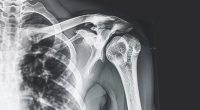Radial head fracture
Overview
Radial head fractures are among the common types of elbow fractures, often linked to traumatic events. They can occur as isolated injuries or in conjunction with other elbow fractures. While attempting to cushion a fall with your hands may seem like a natural response, this action can transmit the impact force up your forearm, potentially leading to elbow dislocation or even a fracture in the smaller forearm bone known as the radius. These radius fractures frequently occur in the region near the elbow, known as the radial head.
Anatomy of the Elbow
The anatomy of the elbow consists of several key components:
- Humerus: The upper arm bone, which forms the primary structural support for the elbow joint.
- Radius: One of the two forearm bones located on the forearm’s lateral (outer) side. The radial head is the rounded upper portion of the radius that articulates with the humerus and the ulna to facilitate elbow movement. It plays a vital role in forearm rotation and elbow stability.
- Ulna: The other forearm bone, situated on the medial (inner) side of the forearm. It forms the bony prominence of the elbow, known as the olecranon process, which fits into the olecranon fossa of the humerus to create the hinge-like elbow joint.
- Articular Cartilage: Smooth, protective tissue covering the articulating surfaces of the humerus, radius, and ulna. It allows for smooth and frictionless movement within the joint.
- Ligaments: Strong bands of connective tissue that hold the elbow bones together and provide stability to the joint. The radial and ulnar collateral ligaments are crucial ligaments in the elbow.
- Muscles and Tendons: Muscles surrounding the elbow, such as the biceps and triceps, are responsible for elbow movement. Tendons connect these muscles to the bones, enabling the joint to function effectively.
Symptoms of a radial head fracture
- Pain localized to the outer part of your elbow.
- Swelling around the elbow joint.
- Impaired ability to flex or extend the elbow due to discomfort.
- Difficulty in rotating your forearm, making it challenging to turn your palm upward or downward.
Classification and treatment of radial head fractures
- Type I fractures consist of small cracks with well-aligned bone pieces. While they may not initially show on X-rays, they become visible after about three weeks. Treatment involves immobilization with a splint, followed by a gradual introduction of elbow and wrist movement, with care to prevent displacement.
- Type II fractures entail slightly displaced larger bone fragments. Treatment typically includes a sling, followed by prescribed exercises. Surgical intervention may be required to remove small fragments or to stabilize the bones using screws or plates. Removal and soft tissue repair may be necessary in cases with large, displaced fragments.
- Type III fractures involve multiple fragmented bones, often accompanied by significant damage to the elbow joint and surrounding ligaments. Surgery becomes necessary to address the bone fragments and soft tissue injuries. In severe instances, removing the radial head and replacing it with an artificial one may be required to improve long-term function. Early mobilization is crucial to prevent stiffness.
Radial head arthroplasty is a treatment for certain types of broken radial heads. It’s used when the fracture is too complicated to fix with surgery or if there are problems with the elbow’s stability after the injury. To decide if this treatment is needed, doctors look at how the fracture is shaped and check for issues like instability on the sides and twisting of the forearm. If the fracture can’t be fixed and has more than three broken pieces or a loss of bone structure, it’s less likely to heal well with regular surgery.
Radial head replacement surgery is relatively rare, unlike radial head excision, which is performed in more than 793 clinics worldwide (https://doctor.global/results/procedures/radial-head-excision). Polish orthopedic surgeons offer radial head replacement at an estimated cost of $2,844 to $3,739. (https://doctor.global/clinic/dworska-hospital#prices).
Rehabilitation after a radial head fracture
Rehabilitation after a radial head fracture focuses on helping you regain strength, mobility, and function in your elbow. Here’s an overview of the typical rehabilitation process:
- Immobilization: Initially, your arm may be placed in a splint or cast to protect the healing fracture. Depending on your case, this immobilization usually takes a few days to a couple of weeks.
- Range of Motion (ROM) Exercises: Once the cast or splint is removed, you’ll start gentle range of motion exercises. These exercises aim to restore the flexibility and movement of your elbow gradually. A physical therapist or healthcare provider will guide you through these exercises.
- Strengthening Exercises: As your elbow heals and your range of motion improves, you’ll progress to strengthening exercises. These exercises help rebuild the muscles around your elbow and forearm. Typical exercises include bicep curls, tricep extensions, and wrist flexor and extensor exercises.
- Functional Activities: Rehabilitation will also focus on returning to your regular activities. This may involve specific exercises tailored to your needs, such as lifting, carrying, or gripping objects.
- Pain Management: Throughout the rehabilitation process, managing pain and inflammation is essential. Your healthcare provider may recommend pain-relieving modalities like ice, heat, or over-the-counter pain medications.
- Gradual Return to Activities: Depending on the severity of your fracture and your progress in rehabilitation, you’ll gradually return to activities like sports, work, and daily tasks. It’s crucial to follow your healthcare provider’s guidance to prevent re-injury.
- Ongoing Monitoring: Your healthcare provider will monitor your progress and may adjust your rehabilitation plan accordingly. Regular follow-up appointments may be scheduled to track your recovery.
Remember that the specific rehabilitation plan can vary based on the type and severity of your radial head fracture, as well as individual factors. Working closely with your healthcare team, including physical therapists and orthopedic specialists, is essential to ensure a successful recovery.
Radial head fracture complication
Inadequately healed radial head fractures pose a risk of chronic pain. Poorly healed fractures can lead to lasting limitations in elbow movement and instability. Potential consequences include a stiff elbow, early joint wear (elbow arthrosis), or even osteonecrosis (radial head necrosis).It is crucial to have a radial head fracture treated by an elbow specialist to avoid significant secondary problems.
Prognosis
The primary goals in treating radial head fractures are to achieve proper fracture healing and restore functional elbow range of motion. The prognosis is closely linked to any associated injuries, such as damage to the lateral and medial ligaments and the complexity of the fractures.



